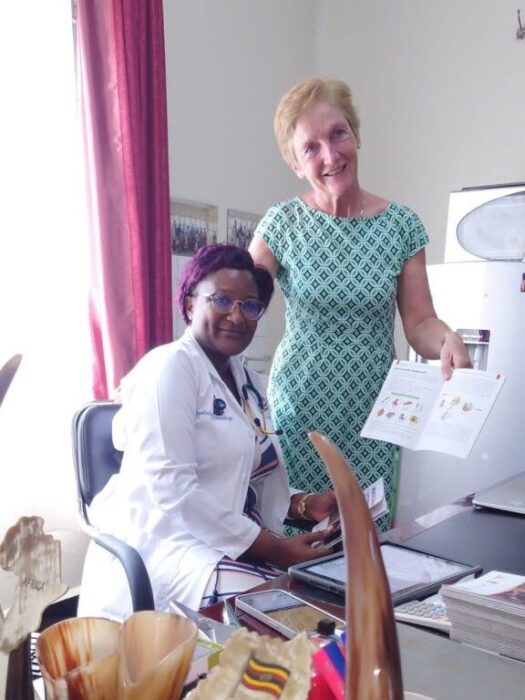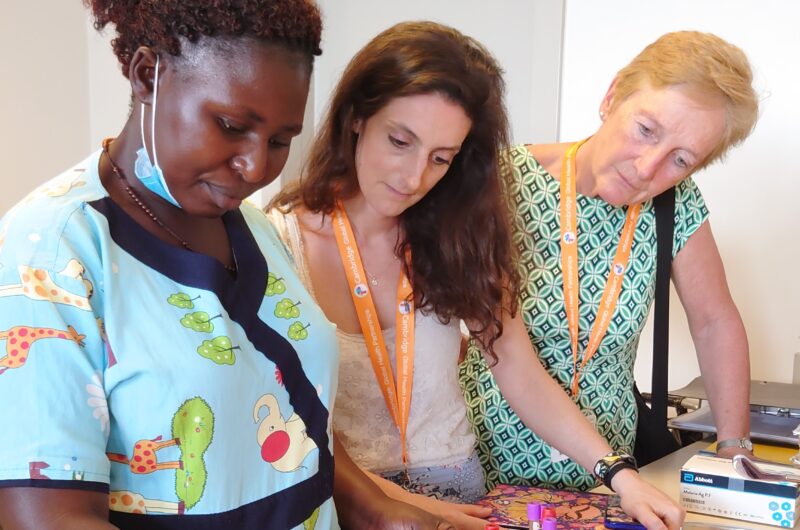Dr Denise Williams is the co-lead of the Paediatric Cancer Health Partnership between Cambridge University Hospitals and the Uganda Cancer Institute (UCI).
She is pictured (right) with Dr Joyce Balagadde (left), co-lead of the partnership at UCI, holding newly developed information leaflets for patients.
How did you get involved with the Cambridge: Kampala Paediatric Cancer partnership?
I’m a paediatric oncologist by background and first met Dr Joyce Balagadde Kambugu, a paediatric oncology consultant from the Ugandan Cancer Institute (UCI) in Kampala, when she visited Cambridge University Hospitals (CUH). She was visiting as part of a wider group, to establish a research collaboration between the Cancer Institute in Cambridge and the UCI in Kampala. Joyce was keen to pursue clinical links between CUH and UCI, as well as the research element. From showing Joyce around, and the discussions we had, I then travelled to Kampala in January 2020 to discuss face to face how we might work together but also to see the context of clinical delivery at UCI. We were able to discuss what would be useful and formulate the next steps to create the Kampala Cambridge Paediatric Cancer health partnership.

How has the partnership progressed?
From the scoping visit we identified several things we could work together on. This included nurse education, safe prescribing and administration chemotherapy, and pathology. The COVID-19 pandemic influenced everything we intended to do. With teams at CUH and UCI coping clinically with the pandemic there was little time for discussions. When we were able to restart discussions, all were done remotely which though possible, were often fraught with internet connection issues. We decided initially to focus on a chemotherapy safety project alone.
During 2020-21, an audit was conducted in Kampala on patients coming in for chemotherapy. The audit analysed the appropriate allocation of chemotherapy protocols to patients and how prescriptions were written, dispensed, monitored, administered.
The results of this audit highlighted several things.
- Children were receiving treatment when clinicians weren’t sure of the precise diagnosis but, because many of the children had advanced disease and were sick, some treatment needed to be started. There needed to be a process to ensure that as soon as the correct diagnosis was made the child’s treatment plan changed so that S/he received the right treatment.
- The audit revealed a need to ensure that the necessary blood tests were carried out before the start of each course and a need to focus on how the prescriptions were written ensuring all drugs were given and that correct fluids were included, as well as supportive medicines such as anti-sickness medication.
To work on these findings, we set up four emergency protocols, to be used until the final diagnosis for a child had been reached and also included a pharmacist at UCI into the partnership. These protocols have been in use for some months and a re-audit is currently taking place. We plan to meet the whole team during our visit in February, address any issues the team may have highlighted or that the re-audit has revealed. We hope then, if all are in agreement, to progress to work with the team at UCI and develop similar templates for the seven most treatable and curable tumours highlighted in the WHO Global Initiative on Childhood Cancer.
It has been identified by the WHO that cancer therapy for children has poor results in many countries. WHO state that by focusing on seven very treatable paediatric cancers, the survival rate could be significantly higher.
- Each year, an estimated 400,000 children and adolescents of 0-19 years old develop cancer (1, 2).
- In high-income countries, five-year survival rates for children with cancer exceed 80%, but in low-and middle-income countries are less than 30%. (2,3).
- Avoidable deaths from childhood cancers in LMICs result from lack of diagnosis, misdiagnosis or delayed diagnosis, obstacles to accessing care, abandonment of treatment, death from toxicity, and relapse. (2, 3)
How has partnership involvement impacted on you?
Firstly, I have really enjoyed it! I greatly value the friendship and trust that has developed from meeting and working with those within the partnership. I am more thoughtful about my approach to discussing issues or difficulties which may arise recognising there are often contextual issues to be considered. Really understanding a partner’s culture, beliefs and working environment as well as some of the local political issues is vital. It has also made me so appreciative of what we have such ready access to in the UK. However, this has also been a source of frustration when I consider the wastage of resources, and lack of appreciation of how lucky we are, within the UK.
Professionally, I think it’s kept me on my toes with new medical treatments and keeps me thinking about what I’m doing and why I’m doing it. Watching and learning with our Ugandan partners, who are a multidisciplinary team of nurses, doctors, and allied health professionals, has been fascinating. They achieve so much without lots of tests or expensive equipment which makes we constantly question our practice in the UK – just because we can doesn’t mean we have to unless it is going to change a patient’s outcome. They also work with far less of a hierarchy than I have previously seen in other LMIC’s. Allowing some autonomy can have extraordinary benefits and there are certainly best practice nursing initiatives that could be mirrored in Cambridge.
Personally, I don’t think you ever stop learning within partnership work; in online meetings and visits I engage with people who have very similar values to me but have completely different experiences and often face many difficulties we never need to consider in the UK. It makes me look in a completely different way at what I have. I think about how I might use what we have to change the way we work, using some of the thoughts and practices we have discussed within the partnership.
Looking to the future, what do you hope for the partnership?
I really hope that we can continue to work together, to support our Ugandan colleagues in some of the challenges they face, and at the same time, identify learning points to bring home. Everything we do is reciprocal. As the partnership continues to grow, I don’t want to lose sight of that, the partnership should continue to feel equitable to colleagues in Uganda and ourselves.
I also hope that we can continue to build on our friendships, based on honesty and mutual respect. In turn, ensuring we get the best from each other by recognising our strengths and weaknesses, and using them to achieve our goal, irrespective of cadre.
And most importantly I would like to think that we can work together in the partnership to really makes a difference to the lives of children with cancer.
References:
- Steliarova-Foucher E, Colombet M, Ries LAG, et al. International incidence of childhood cancer, 2001-10: a population-based registry study. Lancet Oncol. 2017;18(6):719-731.
- World Health Organization. (2021). CureAll framework: WHO global initiative for childhood cancer: increasing access, advancing quality, saving lives. World Health Organization. https://apps.who.int/iris/handle/10665/347370
- Lam CG, Howard SC, Bouffet E, Pritchard-Jones K. Science and health for all children with cancer. Science. 2019 Mar 15;363(6432):1182-1186. doi: 10.1126/science.aaw4892. PMID: 30872518.
Return to case studies

